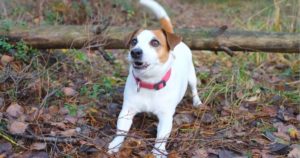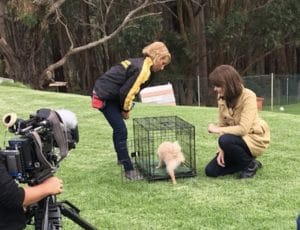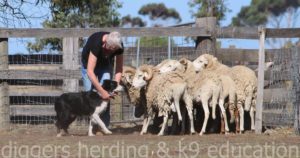
Many dog owners complain about their dog pulling on the lead and want to know what to do about it.
The problem often arises from the fact that their dog has been allowed to rehearse this behaviour over and over again. So, if you have a puppy get on to it straight away.
Dogs often pull from excitement, especially if they don’t get walked every day, and don’t have enough environmental enrichment in their lives to keep their minds and bodies busy. Ensuring that you take your dog on a daily walking, appropriate to their age and breed, plays a bit role in reducing pulling, so even if you are short for time, consider a short scenting walk to help.
The other common factor I have noticed with a dog pulling on lead, is that their owners have pretty much given up with frustration, so they simply continue to get away with it.
The key is to use positive reinforcement training that encourages them to walk calmly next to you, by marking and rewarding them when they aren’t pulling, and literally stopping as soon as they pull to the end of the lead.
So, if your dog tends to pull YOU into the dog park, over to the nearest tree or to say hi to a fellow dog and owner coming your way, then the time is NOW to start taking back control and showing them some fair, but firm, leadership to stop your dog pulling on lead.
For those bigger, stronger pullers, and especially if they’ve been doing it for years, you may need to use a harness or head halter that provides you with a little more control.
Sometimes simply switching from a harness to a head halter or collar or vice versa can stop pulling in its tracks, allowing you to work on your positive reinforcement training and switching back to a normal collar once you have achieved the behaviour modification.
Note that normal harnesses DO NOT help, and can in fact they can make it much easier for dogs to pull, so check out the Rogz Control Stop Pull Harness at Petstock and ask a team member to help you fit it properly. Couple it with their multi lead attachment, so you can control them from both the front and back of the harness.
Make sure you fit it properly and that the adjustable straps aren’t rubbing or digging into your dog anywhere. Don’t allow it to keep pulling tighter or correcting them sharply with the lead, it’s designed to be a supporting tool only and your positive reinforcement training, is the key to long term success.
As is practising it under low distraction first on a quiet street, before slowly introducing other dogs or people as distractions.
If you are consistent with this training, your dog WILL learn that pulling gets them nowhere, and walking calmly on a loose leash gets them to where they want to go.
1. Just Stop!
1) Immediately stop when your dog reaches the end of the lead
2) Call them back to your side, pat your leg or use a treat or food to lure them back to your side and start again.
3) Encourage them with positive reinforcement when they do walk loosely, but again, immediately STOP when your dog pulls on the lead and then lure them back to your side again.
This can be very frustrating for you if you do like to keep moving on your walks, but if you do put the effort in and make sure you do this every time your dog pulls, then it really WILL work as your dog will soon learn that if it pulls, it gets no where at all.
They learn that if they walk by your side, they actually get to keep going on their walk, get to their intended destination (ie: the dog park), and if you also regularly allow them to stop and guide them over to a tree or an area to pee or sniff, then you can control it so you don’t have a dog pulling on lead and taking charge of the walk themselves.
2. Zig Zag technique
If your dog is a chronic puller then the Zig Zag technique might assist with a dog that pulls on lead.
As with both this and the ‘Stop’ technique, it’s best to start under low distraction when no other dogs or people are around and you have plenty of space to allow you to move around in many different directions.
Then build up to a walk down the street, gradually increasing the distractions and continue practicing this even as you make your way into the dog park. Your ultimate goal is to take back control so that you can even calmly walk into the dog park without your dog pulling on lead.
The key steps to stop your dog pulling on the lead with the Zig Zag technique are:
Zig Zag summary
It’s important to remember that the earlier we address problem behaviour the better and the more we allow it to continue and be reinforced the worse it will get.
Dogs will not grow out of this behaviour, so it is up to us to be a firm, fair and consistent leader to help the dog understand what it is we want from them.
About the Author: Lara Shannon is a certified dog behaviourist and trainer, pet food nutrition specialist, Executive Producer and Host of Pooches at Play on Channel 10 and editor of Poochesatplay.com. Lara also runs her own dog training business in Melbourne’s Bayside area and is the Author of World of Dogs and Eat, Play, Love Your Dog

The benefit of interactive toys for dogs


Tropiclean Enticers Kong Dental Ball

The benefits of crate training your dog

How herding training can help with dog behaviour issues


Get your paws on Lara Shannon’s best selling books ‘Eat, Play, Love (your dog) and World of Dogs.
Available in Australia, USA, UK and Canada.